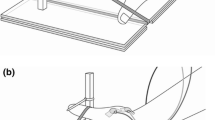Abstract
We recorded somatosensory evoked magnetic fields from ten healthy, right-handed subjects with a 122-channel whole-scalp SQUID magnetometer. The stimuli, exceeding the motor threshold, were delivered alternately to the left and right median nerves at the wrists, with interstimulus intervals of 1, 3, and 5 s. The first responses, peaking around 20 and 35 ms, were explained by activation of the contralateral primary somatosensory cortex (SI) hand area. All subjects showed additional deflections which peaked after 85 ms; the source locations agreed with the sites of the secondary somatosensory cortices (SII) in both hemispheres. The SII responses were typically stronger in the left than the right hemisphere. All subjects had an additional source, not previously reported in human evoked response data, in the contralateral parietal cortex. This source was posterior and medial to the SI hand area, and evidently in the wall of the postcentral sulcus. It was most active at 70–110 ms.
Similar content being viewed by others
References
Ahonen A, Hämäläinen M, Kajola M, Knuutila J, Laine P, Lounasmaa OV, Simola J, Tesche C, Vilkman V (1992) A 122channel magnetometer covering the whole head. Proceedings of the Satellite Symposium on Neuroscience and Technology, 14th Annual International Conference of the IEEE Engineering in Medicine and Biology Society. Lyon, France, pp 16–20
Allison T, McCarthy G, Wood CC, Williamson PD, Spencer DD (1989) Human cortical potentials evoked by stimulation of the median nerve. II. Cytoarchitectonic areas generating long-latency activity. J Neurophysiol 62:711–722
Allison T, McCarthy G, Wood CC (1991) Potentials evoked in human and monkey cerebral cortex by stimulation of the median nerve: a review of scalp and intracranial recordings. Brain 114:2465–2503
Allison T, McCarthy G, Wood CC (1992) The relationship between human long-latency somatosensory evoked potentials recorded from the cortical surface and from the scalp. Electroencephalogr Clin Neurophysiol 84:301–315
Arezzo JC, Vaughan HG, Legatt AD (1981) Topography and intracranial sources of somatosensory evoked potentials in the monkey. II. Cortical components. Electroencephalogr Clin Neurophysiol 51:1–18
Asgari A, Weir AI, Bain R, Maas P, Donaldson GB (1992) Evoked field asymmetry of human second somatosensory areas in dominant and non-dominant hemispheres. Proceedings of the Satellite Symposium on Neuroscience and Technology, 14th Annual International Conference of the IEEE Engineering in Medicine and Biology Society. Lyon, France, pp 24–27
Clemo HR, Stein BE (1982) Somatosensory cortex: a “new” somatotopic representation. Brain Res 235:162–168
Darian-Smith I, Isbister J, Mok H, Yokota T (1966) Somatic sensory cortical projection areas excited by tactile stimulation of the cat: a triple representation. J Physiol (Lond) 182:671–689
Desmedt JE, Cheron G (1981) Non-cephalic reference recording of early somatosensory potentials to finger stimulation in adult or aging normal man: differentiation of widespread N18 and contralateral N20 from the prerolandic P22 and N30 components. Electroencephalogr Clin Neurophysiol 52:553–570
Duffy FH, Burchfield JL (1971) Organizational hierarchy from single units in monkey area 5. Science 172:273–275
Forss N, Hari R, Salmelin R, Ahonen A, Hämäläinen M, Kajola M, Knuutila J, Simola J (1993) Simultaneous whole-head mapping of median nerve somatosensory evoked magnetic fields (abstract). XXXII Congress of the International Union of Physiological Sciences 123
Goff WR, Williamson PD, VanGilder JC, Allison T, Fisher TC (1980) Neural origins of long latency evoked potentials recorded from the depth and from the cortical surface of the brain in man. In: Desmedt JE (eds) Clinical uses of cerebral, brainstem and spinal somatosensory evoked potentials. (Progress in clinical neurophysiology, vol 7) Karger, Basel, pp 126–145
Hari R, Reinikainen K, Kaukoranta E, Hämäläinen M, Ilmoniemi R, Penttinen A, Salminen J, Teszner D (1984) Somatosensory evoked cerebral magnetic fields from SI and SII in man. Electroencephalogr Clin Neurophysiol 57:254–263
Hari R, Karhu J, Hämäläinen M, Knuutila J, Salonen O, Sams M, Vilkman V (1993) Functional organization of the human first and second somatosensory cortices: a neuromagnetic study. Eur J Neurosci 5:724–734
Hyvärinen J (1982) The parietal cortex of monkey and man. Springer, Heidelberg Berlin New York
Kaas JH (1990) Somatosensory system. In: Paxinos G (eds) The human nervous system. Academic, San Diego, pp 813–844
Kaukoranta E, Hari R, Hämäläinen M, Huttunen J (1986) Cerebral magnetic fields evoked by peroneal nerve stimulation. Somatosens Res 3:309–321
Leinonen L, Hyvärinen J, Nyman G, Linnankoski I (1979) Functional properties of neurons in lateral part of associative area 7 in awake monkey. Exp Brain Res 34:299–320
Libet B, Alberts WW, Wright EW, Lewis M Jr, Feinstein B (1975) Cortical representation of evoked potentials relative to conscious sensory responses, and of somatosensory qualities in man. In: Kornhuber HH (eds) The somatosensory system. Thieme, Stuttgart, pp 291–308
Mackay WA, Kwan MC, Murphy JT, Wong YC (1978) Responses to active and passive wrist rotation in area 5 of awake monkeys. Neurosci Lett 10:235–239
Mountcastle VB, Lynch JC, Georgopoulos A, Sakata H, Acuna C (1975) Posterior parietal association cortex of the monkey: command functions for operations within extrapersonal space. J Neurophysiol 38:871–908
Papakostopoulos D, Crow HJ (1980) Direct recording of the somatosensory evoked potentials from the cerebral cortex of man and the difference between precentral and postcentral potentials. In: Desmedt JE (eds) Clinical uses of cerebral, brainstem and spinal somatosensory evoked potentials (Progress in clinical neurophysiology, vol 7) Karger, Basel, pp 15–27
Penfield W, Jasper H (1954) Epilepsy and the functional anatomy of the human brain. Churchill, London
Sakata H, Takaoka A, Kawarasaki A, Shibutani H (1973) Somatosensory properties of neurons in superior parietal cortex (area 5) of the rhesus monkey. Brain Res 64:85–102
Tissari S, Hämäläinen MS, Hari R, Mäkelä JP (1993) Sources of auditory evoked fields superimposed on 3D-MRI reconstructions of temporal lobes (abstract). Adv Biomagnetism 138–139
Author information
Authors and Affiliations
Rights and permissions
About this article
Cite this article
Forss, N., Hari, R., Salmelin, R. et al. Activation of the human posterior parietal cortex by median nerve stimulation. Exp Brain Res 99, 309–315 (1994). https://doi.org/10.1007/BF00239597
Received:
Accepted:
Issue Date:
DOI: https://doi.org/10.1007/BF00239597




